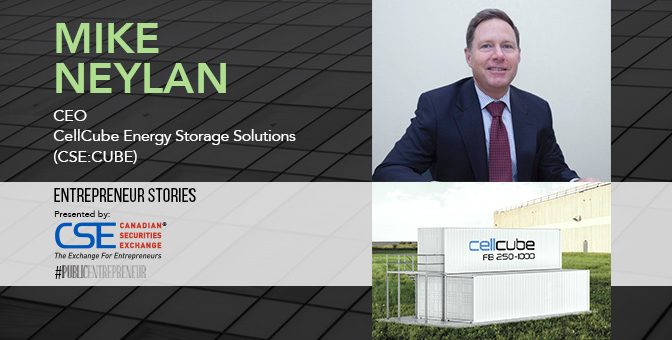Smoothing the path between renewable energy and its end-user
The path toward clean energy has proved to be a bumpy one. Misconceptions about the viability and reliability of renewable energy sources have sometimes hindered progress.
CellCube Energy Storage Systems Inc. (CSE:CUBE; OTCQB CECBF; Frankfurt 01X) has heard all the questions and concerns. How does solar power work when the sun goes down? How do you utilize wind power on a not-so-breezy day? The company has found that the missing link between clean, renewable energy and intermittency is in energy storage.
Despite the confusion about just how clean energy works, CellCube Chief Executive Officer Mike Neylan believes that a societal transition from fossil fuels to cleaner or renewable sources is well underway.
“The fundamental need for large-scale energy storage is driven by the increased integration of renewable energy into the electricity grid,” says Neylan.
Neylan, with over 20 years of corporate experience under his belt, has a blend of energy know-how and the financial experience to back it up. Formerly, he was a private equity portfolio manager with alternative investment manager Sprott Inc. and oversaw an investment fund focused on physical power trading when he was the chief operating officer of Aquilon Power Corp.
Renewable energy generation has been increasing, spurred on by the rapid growth in solar and wind power generation, according to a study by the International Renewable Energy Agency.
Solar power generation has increased by 31% compared with 2015 while wind power generation is up by 16%, as per the study. A total of US$19 billion worth of public investment was put into renewables in 2016. According to Bloomberg New Energy Finance research, storage markets are estimated to reach 40GW by 2030 and are expected to spend over $100 billion in the ramp-up phase over the same period.
“Climate change is driving decarbonization and the increase of renewable sources powering the electricity grid,” says Neylan. “Consumers are looking for cleaner sources of energy with the same duration and reliability that they’re accustomed to having. Clean energy sources backed up by a long duration energy storage system fit the bill.”
Most commodities have always been able to be stored, like water in a reservoir or grain in a silo. Until relatively recently, there was little technical capacity for storing grid-scale electricity except through pumped hydro projects – which are expensive and have geographical constraints. Production would have to always meet demand to avoid waste and ensure a reliable and balanced grid.
CellCube stores energy by way of a vanadium redox flow battery, a brainchild of NASA in the 1970s.
Named after Vanadis, the Norse goddess of beauty, vanadium is a silvery, ductile metal known for its brilliant colors and for making steel stronger. Vanadium salts are non-flammable and non-explosive, increasing safety and battery life.
CellCube’s vanadium redox flow batteries provide 100% useable energy without impacting product life – there is no capacity degradation. The energy storage system comes as a containerized solution with scalable multi-unit modules that can provide grid-scale rated power and between four to eight hours of energy storage.
A battery’s cycle starts when the battery is fully charged and ends once it has been discharged, or all the stored energy has been used up, and then it’s recharged again.
Unlike other technologies on the market, CellCube’s energy storage system doesn’t suffer from cycling dependency and has a much longer lifespan – lasting more than 20,000 cycles. The battery is ideal for long-term renewable energy projects with a lifespan matching that of conventional power generation assets at 30+ years.
If there is ever a service interruption, CellCube receives an alert so that they can respond promptly and keep the energy flowing while reducing the cost of wasted energy. The battery can be looked after around-the-clock or be monitored remotely.
In the past, electricity storage was limited to small electrical-chemical batteries like lead acid or nickel-cadmium batteries. Lithium-ion batteries grew in popularity but were better suited for short-term storage. Vanadium batteries are better equipped for large-scale stationary energy storage, according to CellCube.
The Toronto-based company has original units that have been operating for nearly 10 years, or 11,000 battery cycles. In total, there are 130 installations in 24 countries, including units in the Kalahari Desert in Southern Africa and famously frigid Siberia.
Its adaptiveness to weather extremes also sets the battery apart from the competition.
While some parts of the world look toward clean energy, other parts are still in the dark. CellCube has the capacity to bring electrification to future generations in rural areas.
Excess renewable energy can be stored and then fed into a microgrid, or an electricity grid separate from the mainframe grid. A diesel generator, less expensive than gasoline but a nonrenewable form of energy, can be used to charge the CellCube, but a shift to clean energy may lead to more autonomy for distant communities.
“If you dovetail it with solar or wind, then you have a cheap, clean, renewable source of energy driving the power but used in conjunction with storage, you have a much more efficient system completely independent from the grid,” says Neylan. “So, it allows communities that are isolated in any particular way to really assume control for their own power generation systems and to do so on an economic basis and on a clean basis.”
CellCube is looking to pave the rough road to renewable energy by providing consumers in all locations and climates with cleaner energy they can depend on to power their lives in rain or shine.
This story was originally published at www.proactiveinvestors.com on August 31, 2018 and featured in The Public Entrepreneur magazine.
Learn more about CellCube Energy Storage Systems. at https://www.cellcubeenergystorage.com/ and on the CSE website at https://thecse.com/en/listings/mining/cellcube-energy-storage-systems-inc.

